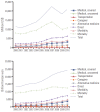Economic Burden of Cancer in Korea during 2000-2010
- PMID: 25672582
- PMCID: PMC4506103
- DOI: 10.4143/crt.2014.001
Economic Burden of Cancer in Korea during 2000-2010
Abstract
Purpose: This study estimated the economic burden of cancer in Korea during 2000-2010 by cancer site, gender, age group, and cost component.
Materials and methods: Data came from national health insurance claims data and information from Statistics Korea. Based on the cost of illness method, this study calculated direct, morbidity and mortality cost of cancer in the nation during 2000-2010 by cancer site, gender, and age group.
Results: With an average annual growth rate of 8.9%, the economic burden of cancer in Korea increased from 11,424 to 20,858 million US$ (current US dollars) during 2000-2010. Colorectal, thyroid, and breast cancers became more significant during the period, i.e., the 5th/837, the 11th/257, and the 7th/529 in 2000 to the 3rd/2,210, the 5th/1,724, and the 6th/1,659 in 2010, respectively (rank/amount in million US$ for the total population). In addition, liver and stomach cancers were prominent during the period in terms of the same measures, i.e., the 1st/2,065 and the 2nd/2,036 in 2000 to the 1st/3,114 and the 2nd/3,046 in 2010, respectively. Finally, the share of mortality cost in the total burden dropped from 71% to 51% in Korea during 2000-2010, led by colorectal, thyroid, breast, and prostate cancers during the period. These results show that the economic burden of cancer in Korea is characterized by an increasing importance of chronic components.
Conclusion: Incorporation of distinctive epidemiological, sociocultural contexts into Korea's cancer control program, with greater emphasis on primary prevention such as sodium-controlled diet and hepatitis B vaccination, may be needed.
Keywords: Aging; Burden of illness; Cancer; Incidence.
Conflict of interest statement
Conflict of interest relevant to this article was not reported.
Figures
References
-
- World Bank . World development indicators [Internet] Washington, DC: World Bank; 2013. [cited 2013 Oct 18]. Available from: http://databank.worldbank.org/data/home.aspx.
-
- Jemal A, Siegel R, Ward E, Hao Y, Xu J, Murray T, et al. Cancer statistics, 2008. CA Cancer J Clin. 2008;58:71–96. - PubMed
-
- Cooper BS, Rice DP. The economic cost of illness revisited. Soc Secur Bull. 1976;39:21–36. - PubMed
-
- National Heart, Lung and Blood Institute . NHLBI fact book, fiscal year 2007. Bethesda: National Heart, Lung and Blood Institute; 2008.
LinkOut - more resources
Full Text Sources
Other Literature Sources



